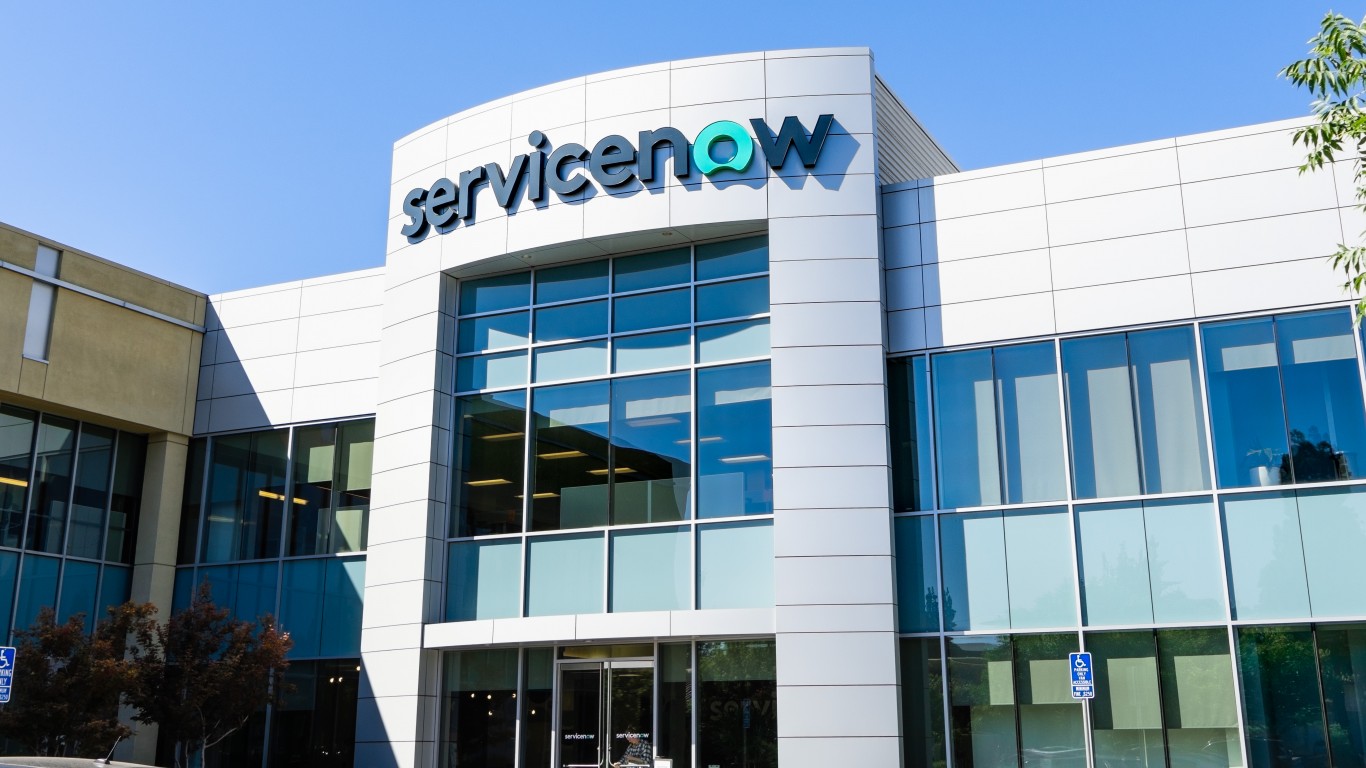Investing
NVIDIA Reveals Plan to Reverse Its Stock Slide - Will It Work?

Published:
Last Updated:

NVIDIA‘s (Nasdaq: NVDA) stock is now down more than 20% from its peak intraday price of $140.76. Several factors are weighing on the company’s share price, but one of the strongest is the belief that the current surge in chip sales is temporary.
It looks like NVIDIA will take that idea head-on in its next earnings report. Let’s look at what NVIDIA is reportedly planning to reveal and whether it could reverse the company’s stock slide.

Goldman Sachs is reporting that NVIDIA is going to highlight profits made by end customers on its next earnings call. The company has done this in the past, but often in more vague statements around ROI.
Here’s an example from NVIDIA’s most recent call:
“Training and inferencing AI on NVIDIA CUDA is driving meaningful acceleration in cloud rental revenue growth, delivering an immediate and strong return on cloud providers’ investment. For every $1 spent on NVIDIA AI infrastructure, cloud providers have an opportunity to earn $5 in GPU instant hosting revenue over 4 years.”
NVIDIA is currently fighting on two fronts in the GPU market; the first is ‘training.’
In that market, NVIDIA is more dominant. Customers are currently spending vast sums for ever more complex models. Spending in the training market seems a bit more secure as customers aren’t necessarily spending to an ROI figure, but rather in an “arm’s race” to push the capabilities of their leading models further.
The second front NVIDIA is fighting is on ‘inferencing.’
Inferencing happens after models are trained. It’s using the models to actually make predictions. In this market, NVIDIA is less dominant. NVIDIA estimates about 40% of their revenue comes from inferencing, but it’s a market where large cloud providers like Amazon (Nasdaq: AMZN), Alphabet (Nasdaq: GOOGL), and Microsoft (Nasdaq: MSFT) continue developing custom chips primarily intended to be more cost-efficient in inferencing.
There is also a question of just how much inferencing capacity is needed. Some Wall Street estimates say inferencing capacity is already exceeding near-term needs. Another factor is that if a lot of inferencing demand is coming from large cloud companies. This is a part of the market driven far more by ROI. That is to say, large cloud companies have P&Ls that Wall Street watches closely. If they’re losing money because large orders for chips intended for inferencing aren’t being rented by customers, they’ll pull back on orders far more quickly.
When companies issue earnings, its a chance for them to tell their side of the story. So it makes sense that NVIDIA would want to use its earnings to give investors added confidence customers are actually seeing solid returns on their GPU purchases.
Let’s explore a couple ‘case studies’ below where customers are seeing real revenue from NVIDIA’s GPU chips. Then we’ll end with a more cautionary example.
It’s estimated that Meta (Nasdaq: META) is NVIDIA’s second-largest customer, trailing only Microsoft. With this level of massive spend, whether or not Meta is seeing positive ROI has been a huge question among investors.
Wall Street researcher Bernstein recently did the math, and their numbers are very positive for NVIDIA investors. Bernstein estimates the following:
It’s worth noting these figures for Meta are estimates. However, this is exactly the kind of concrete example NVIDIA needs to help allay fears around the return on buying their AI chips.
While it’s common for NVIDIA bears to cite a lack of revenue or “killer apps” in the AI space, it’s estimated Meta is generating an incremental $16.3 billion at a 22% ROIC. That’s probably the single best case study on what AI investments can produce!

ServiceNow (NYSE: NOW) reported earnings this week and was up more than 15% the next day. One focus of the company’s earnings call was how AI products and services to customers had driven their revenue beat. Here is a highlight from their earnings call:
“Moving to the topic of AI. Now Assist net new ACV doubled quarter-over-quarter, significantly overachieving our expectations, and it became the fastest-growing new product in the company’s history. We signed 11 Now Assist deals with $1 million-plus NNACV in Q2, two of which were over $5 million. We had impressive wins across industries, from banking, health care and manufacturing, to semis, tech and many others.”
“As an AI Lighthouse customer, Stellantis is using ServiceNow as its strategic AI platform to manage operations across HR, finance and supply chain. American Honda selected Now Assist as their GenAI solution of choice to improve deflection and efficiency of service, delivering a world-class experience to their employees.
Merck is using the ServiceNow platform to streamline operations across IT and cybersecurity to advance its global biopharmaceutical business. Adobe will leverage Now Assist to optimize routine tasks for employees, which will increase efficiency across the entire organization. Dell will integrate Now Assist with its service capabilities to deliver a seamless customer and employee experience.
And with Now Assist, ST Microelectronics plans to enhance productivity and user experiences across their entire organization. LTIMindtree is using Now Assist for ITSM to increase developer productivity by 30% with code and flow generation. We’re also collaborating together to grow and expand offerings in finance and supply chain workflows.”
Obviously, a lot from the quotes above won’t make sense unless you actively follow ServiceNow’s business. However, here’s the key point: ServiceNow used specific examples from across industries – automotive, healthcare, semiconductors – to show how generative AI is being adopted broadly across industries.
This is likely what NVIDIA will attempt to do in their own earnings as well. Show with as much clarity as allowed specifically how customers in a broad series of industries are using their chips and the kinds of returns they’re seeing.
Finally, let’s end with what could be a reason for concern from this earnings season. Alphabet issued earnings and all the call received a number of questions about the ROIC they were seeing from their AI infrastructure investments. The commentary from their CEO, Sundar Pichai, was fairly muted:
“Look, I – obviously, we are at an early stage of, what I view, as a very transformative area and in technology where you’re going through these transitions, aggressively investing upfront in a defining category, particularly in an area where in a leverage way cuts across all our core areas of products, including search, YouTube and other services as well as fuels growth in cloud and supports the innovative long-term bets and Other Bets is definitely something for us makes sense to lean in.
I think the one way I think about it is when we go through a curve like this, the risk of under-investing is dramatically greater than the risk of over-investing for us here, even in scenarios where if it turns out that we are over-investing, we clearly – these are infrastructure, which is widely useful for us. They have long useful lives and we can apply it across, and we can work through that. But I think not investing to be at the front here, I think, definitely has much more significant downside.”
The key point here is that Pichai seems to say, “If we’re not getting great ROIC from customers, we can also use our AI chips for internal projects and decelerate investments.”
That’s a practical way of looking at the market. However, it plays into the point made by bears in the AI market. That is to say that while companies feel like they need to invest to keep up right now, pretty soon large hyperscalers like Google will run the numbers and see that they’ve overinvested. At this point, the market could see a correction that would be very bad for NVIDIA’s share price.
It’s now up to NVIDIA to begin countering this narrative. Pay close attention to what they highlight in their next earnings. It could go a long way in deciding whether NVIDIA’s stock runs in the second half or stays in neutral.
The next trend in AI is pushing from clusters of thousands of AI chips to perhaps a million or more. This mega-trend will create new winners which we’ve detailed in our brand-new “The Next NVIDIA report.”
The report is complimentary, but available for a limited time only. Make sure to grab a copy as breakthroughs in the space are moving at an extremely rapid pace.
Thank you for reading! Have some feedback for us?
Contact the 24/7 Wall St. editorial team.